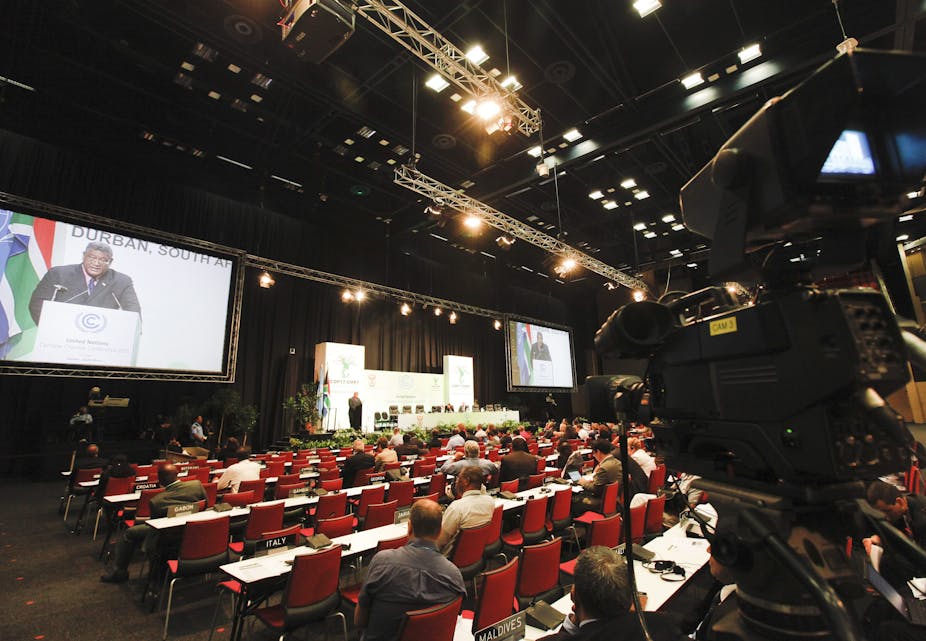DURBAN CLIMATE CHANGE CONFERENCE: Onlookers often wonder why it is so hard to reach an agreement on dealing with climate change. Every so often the United Nations Framework Convention on Climate Change (UNFCCC) convenes a meeting – variously knows as a Conference of the Parties (COP), Meeting of the Parties (CMP) or by the shorthand title of its location – and at the end of each meeting the media generally reports that “nothing happened”.
I am attending COP17, also known as CMP7 and “Durban”. My interest is in carbon capture and storage (CCS), and I have been participating in meetings aimed at having CCS included as an off-setting activity in the Clean Development Mechanism (CDM). This Mechanism is one of three Kyoto Protocol market mechanisms encouraging developed countries to start mitigation projects in developing countries. To have CCS included, we need to settle on a comprehensive set of rules for CCS’ operation.
The procedure is complicated and detail-oriented. I outline it here in the hope it will give you an insight into not only CCS, but into how difficult it is to reach agreement at a COP.
Carbon capture and storage has been high on the agenda at the current Durban climate change meeting. The conference’s opening ceremony was immediately followed by a plenary meeting of the Subsidiary Body for Scientific and Technological Advice (SBSTA) at which carbon capture and storage (CCS) was considered.
The journey to Durban has been, at times, challenging for CCS. According to the International Energy Agency (IEA), CCS could provide 19% of the total abatement required to hold atmospheric greenhouse gas emissions to 450 parts-per-million by 2050. The Intergovernmental Panel on Climate Change’s (IPCC) Special Report on CCS estimates that CCS could provide between 15% and 55% of the required abatement to 2100.
There are many issues to resolve before CCS can be considered in the CDM. Meetings have been held to discuss its long-term permanence; measuring, reporting and verification; environmental impacts assessments and safety; defining project boundaries; intersection of domestic and international laws; allocation of liability (both operational and contingent); and financial provision to redress any prospect of localised physical and environmental damage from CCS activities.
CCS is already formally acknowledged in the Kyoto Protocol. In its 2005 Special Report, the IPCC concluded there are no insurmountable technical barriers to deploying CCS. Its Guidelines for National Greenhouse Gas Inventories (NGGI) included specific guidance on how to account for emissions from CCS (including transport and storage).
At the beginning of week 1 at Durban, the Subsidiary Body for Scientific and Technological Advice Chair immediately established a Contact Group to start the negotiations on the draft text of the rules of CCS in the Clean Development Mechanism. In drafting these, the Contact Group considered:
- decisions made at the Cancun meeting last year
- the written submissions to its submission process (which concluded in February 2011)
- a dialogue and formal report emanating from a UNFCCC-hosted Expert CCS workshop in Abu Dhabi in September.
From the moment the Contact Group commenced, to the Subsidiary Body’s formal consideration of its conclusions on Saturday December 3, more than 20 hours of intense debate occurred.
Most of the 23-page rules document (known as FCCC/SBSTA/2011/L.24) has been agreed to, but two core issues remain:
- the long-term liability, and
- the scale of the financial provisions required for the operational stage (including the required 20 years monitoring period post-site closure).
Delegates have raised some options to address long-term liability. These include:
- either the host party and/or the Annex I Party takes on liability (proposed by the UNFCCC )
- the host party takes on liability (proposed by the European Union)
- Annex 1 parties take on liability (proposed by Brazil).
Whichever option ultimately prevails could have a material consequence for whether a project will proceed or not. It will affect the certified emissions reductions generated and their market value.
The Subsidiary Body agreed to allocate a fixed amount of certified emissions reductions to a “reserve” account in the Clean Development Mechanism registry. These will provide for any costs associated with leakage and/or seepage that happens before liability is transferred. The UNFCCC Secretariat originally suggested 5% (which was scrapped), but then Brazil formally proposed 20% and Australia 2%. A third option of x% was also proposed – those delegates weren’t prepared to commit to a figure.
Clearly, the negotiations now reflect political posturing on non-technical issues.
The likelihood of these issues being resolved before Friday depends very much on whether the UNFCCC President (currently the South African International Relations Minister, Maite Nkoana-Mashabane) can secure high-level ministerial consensus on which of the broad range of options still on the table is preferred.
A decision to accept the rules and procedures at the Durban meeting would strongly complement the Cancun decision to recognise CCS projects in the Clean Development Mechanism: it would provide the rules for project engagement.
If projects are to be recognised and rewarded under the Mechanism, then all parties involved will have to be happy with the solutions to the two non-trivial matters mentioned above.
Later today (Durban time), there will be a formal meeting to consider and make decisions on Subsidiary Body conclusions (including how to incorporate CCS in the Clean Development Mechanism). It will be an exciting finish to a long period of negotiation.
The Global CCS Institute is affiliated with the research community through its membership base.

